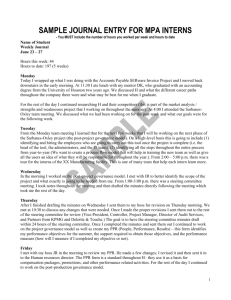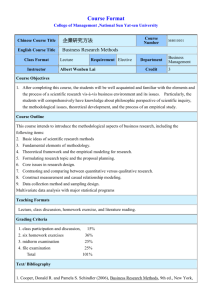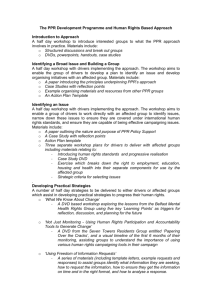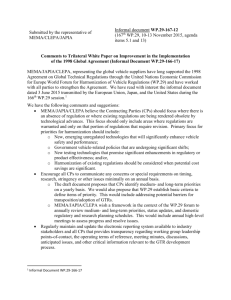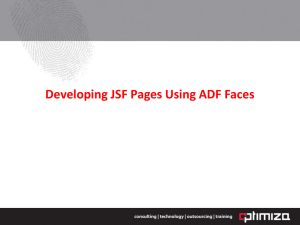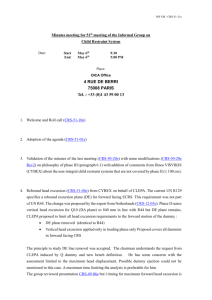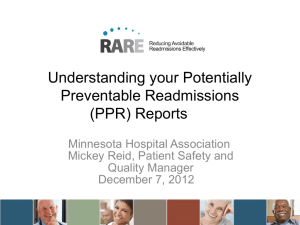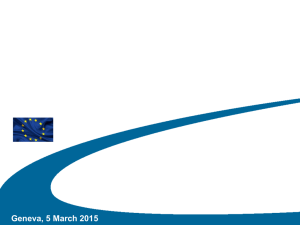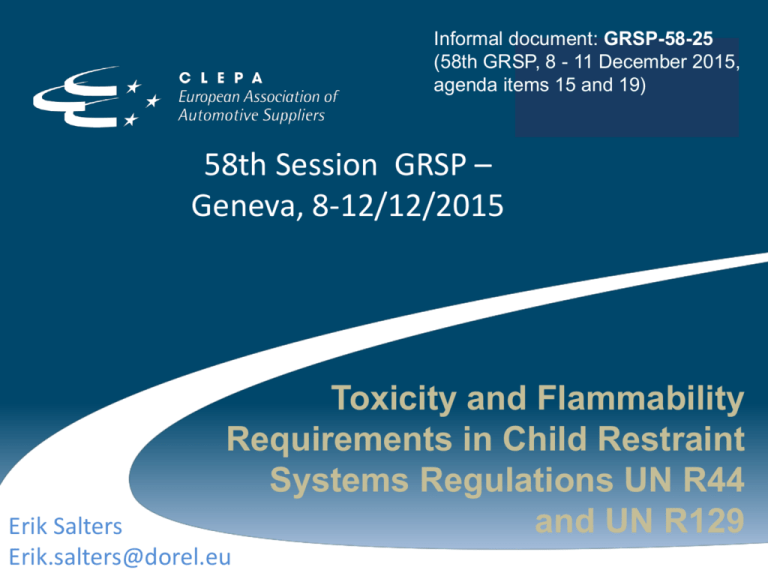
Informal document: GRSP-58-25
(58th GRSP, 8 - 11 December 2015,
agenda items 15 and 19)
58th Session GRSP –
Geneva, 8-12/12/2015
Toxicity and Flammability
Requirements in Child Restraint
Systems Regulations UN R44
and UN R129
Erik Salters
Erik.salters@dorel.eu
UPDATING THE REFERENCES TO THE EUROPEAN
STANDARD ON TOXICITY AND FLAMMABILITY
GRSP 57th session agreed to resume discussion in the 58th session on
the basis of a revised proposal tabled by the expert from CLEPA in
cooperation with the expert from OICA.
A recap of the considerations needed to discuss this topic:
•
•
•
•
•
Child safety needs to balance flammability requirements with those related
to toxicity. EN 71 standard was specifically written for this purpose and deals
with products that are in close contact with children.
This view is also shared by consumer testing, where chemical testing is
conducted on child restraint parts that are likely to come into contact with the
mouth of the child.
Child care products already need to fullfill the EN71-2 standard
GRSP’s May 2015 session favoured the EN71 standard for alignment of
R129 and R44.
It is also important to define which testing methods and criteria are used.
Clepa is asking GRSP to consider these aspects.
Copyright © 2015 CLEPA. All rights reserved. www.clepa.eu
FLAMMABILITY
(SUMMARY OF 57TH GRSP)
In the last GRSP a request was made to CLEPA to show that
the requirements for child protection are not lowered by the
proposed reference to EN71-2 2011 § 4.4 vs the R44
method.
This is what we did:
• CLEPA compared the performance of materials used in current child
seats.
• Accidentology does not show problems with the materials used today.
• A comparison was made, testing the materials against the R44
standard, and the EN71-2 standard.
Test method
Requirement
ECE 44 Trans/WP 28/78/rev1 aug 1997
250mm/min
EN 71-2 2011 § 4.4
30 mm/sec
Copyright © 2015 CLEPA. All rights reserved. www.clepa.eu
SAMPLES TESTED
29 DIFFERENT MATERIALS
# Material
R44
DNI = does not ignite
SE = Self extinguishing
EN71-2
#
Material
1 100% PES
118 SE
2,2
16 100% Cotton
2 100% PES
DNI
DNI
17
3 100% PES
SE
29,9
4 100 % PES
86,8
3,2
5 100 % PES
DNI
1,1
6 100 % PES
DNI
7,5
7 100% PES
SE/NBR
2,8
30% Acryl, 30% PES, 25%
8 Nylon, 15% BW
54,4
Florgewebe
30% Acryl, 30% PES, 25%
9 Nylon, 15% BW
DNI
Florgewebe
NBR = No Burn Rate
IBE = extinguished after
removal of flame
65% Polye
35% Cot
18 100% Polye
R44
EN71-2
43
17,05
140
13,74
0
IBE
78
11,42
20 100% Poly
0
IBE
21 100% Polye
0
7,91
22
100% Polye
Scraped
0
IBE
23
65% Polye
35% Ray
180
11,72
24 100% Polye
138,6
7,73
19
19,0
65% Polye
35% Ray
6,5
10 100 % PES
DNI
DNI
11 100 % PES
SE/NBR **
0,8
25 100% polye
152
9,43
12 EPS 40 g/cm3 / 15 mm
SE
SE
26 100% Polyester
4,8
0
EPS EPS 40 g/cm3 /
30mm
SE
SE
27
0
0
14 EPS 20 g/cm3 / 15 mm,
SE
SE
100% Polyester with 2mm
foam laminated
100% Polyester with 6mm
28
foam laminated
0
0
15 EPS 20 g/cm3 / 30 mm
SE
SE
29 Neoprene
8,9
90
13
FLAMMABILITY
For each material, we conducted 2 tests, one to the R44
test, and another to the EN71-2 specifications.
We normalized the burning rate results to their respective
limits. To do this, we assessed how much % of the
maximum allowed burning rate is used.
– Example EN 71-2 2011 § 4.4 (Req 30 mm/sec)
• Material A burned 22 mm in 1 sec, of a limit of 30 mm = 73% used,
22mm
27% ‘buffer’ remaining.
Copyright © 2015 CLEPA. All rights reserved. www.clepa.eu
FLAMMABILITY
Comparing 2 different tests
Test 1 Material A burned 22 mm in 1 sec. The limit is 30 mm = 73% used, 27%
‘buffer’ remaining.
Test 2
22mm
Same material (A) burned 180 mm in 1 min. The limit is 250 mm = 72%
used, 28% ‘buffer’ remaining.
180mm
These test show that for this material, both tests are equal in severity
(72% vs 73%)
Copyright © 2015 CLEPA. All rights reserved. www.clepa.eu
A RELATIVE COMPARISON OF
R44 VS EN71-2
120
100
80
ECE R44 Trans WP 28[%] result vs. Limit
EN 71-2+A1 : 04/2014 §5.4[%] result vs. Limit
60
40
20
%
0
1 2 3 4 5 6 7 8 9 10 11 12 13 14 15 16 17 18 19 20 21 22 23 24 25 26 27 28 29
29 materials are tested twice:
• For each material 2 tests are conducted, the green rectangle
indicates such a ‘pair’.
• No bar means no value; “Self Extinguished” or “no burn”
Session 1/2015, 24-25 February 2015
• Sample 3 fails EN71-2
(100% burn), but passes7 R44 (no burn)
A RELATIVE COMPARISON OF
R44 VS EN71-2
120
100
80
ECE R44 Trans WP 28[%] result vs. Limit
EN 71-2+A1 : 04/2014 §5.4[%] result vs. Limit
60
40
20
%
0
1 2 3 4 5 6 7 8 9 10 11 12 13 14 15 16 17 18 19 20 21 22 23 24 25 26 27 28 29
- Green circle indicates comparable R44 / EN71-2 result pair (19)
- Blue square indicates a difference in results; R44 is more stringent (4)
- Red square indicates a difference in results; EN71 is more stringent (6)
Session 1/2015, 24-25 February 2015
8
ARE REQUIREMENTS FOR CHILD PROTECTION LOWERED
WITH THE PROPOSED EN71-2 2011 § 4.4 VS THE R44
METHOD?
• 19 tests show
comparable results.
• 6 tests show that
EN71-2 is more
severe
• 4 tests show that
R44 is more severe
HOW TO TEST SANDWICH MATERIALS?
Composite material
Non composite material
• “Composite material" means
a material composed of
several layers of similar or
different materials intimately
held together at their
surfaces by cementing,
bonding, cladding, welding,
etc. In such a case the
material is tested as a
composite.
• When different materials are
connected together
intermittently (for example,
by sewing, high-frequency
welding, riveting), such
materials shall not be
considered as composite
materials and therefore
tested separately
CONCLUSIONS
Although the 2 tests are not a literal translation of each
other, they do not lower or increase the overall protection
for childeren against fire hazard.
• For child safety there is a need to balance flammability
requirements with those related to toxicity
• Clepa is asking GRSP to consider its May’s proposal in
light of these explanatory notes
Copyright © 2015 CLEPA. All rights reserved. www.clepa.eu


